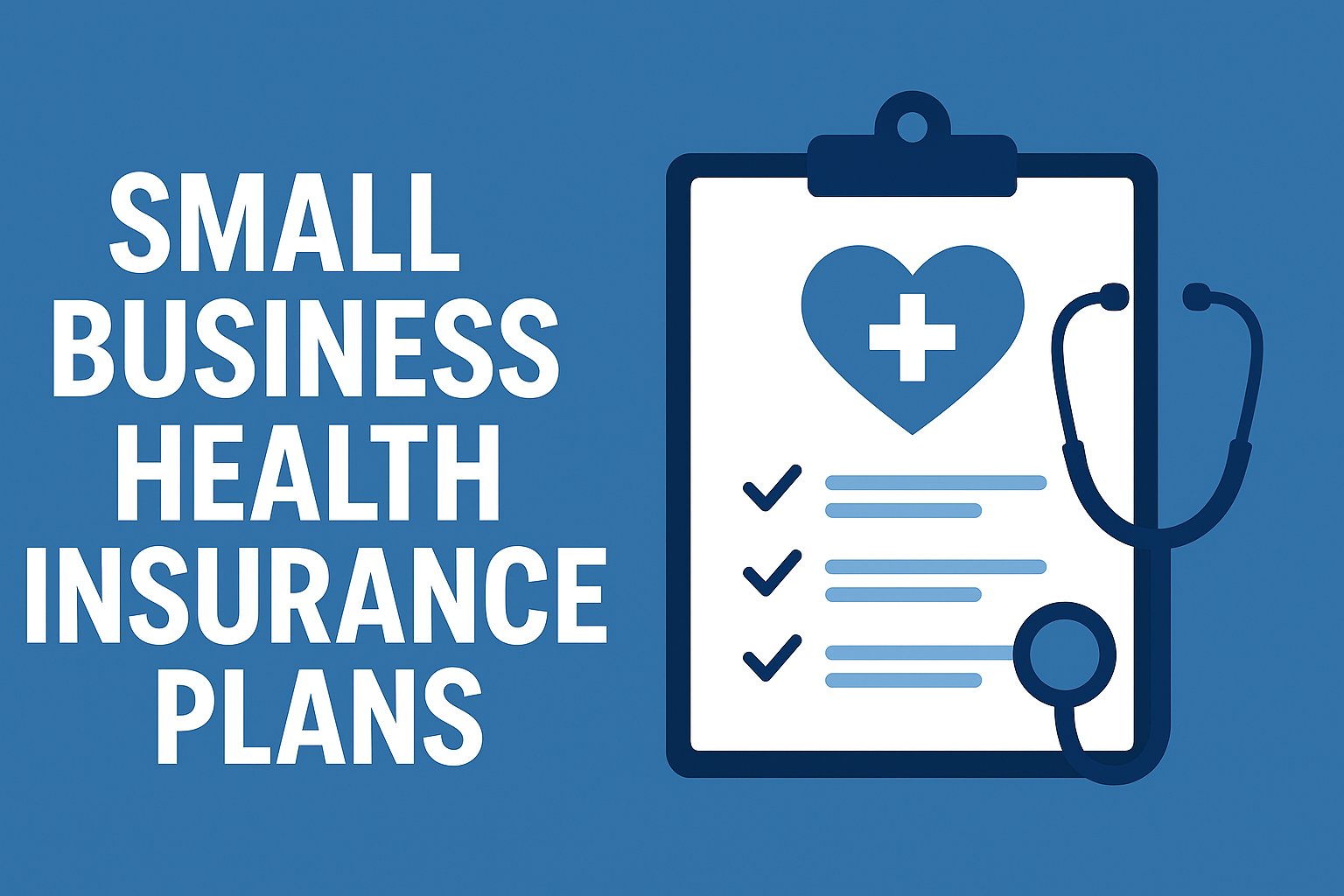Running a small business is about balancing growth with responsibility — and one of the most powerful commitments you can make to your employees is providing quality health insurance. In markets like the US, UK, Canada, and Australia, where health costs can easily overwhelm individuals, small business health insurance plans serve as both a protection and a growth strategy.
Many small business owners hesitate, believing insurance is too costly or complex. However, modern business health insurance small programs are designed with flexibility, affordability, and government incentives in mind. Employers can now access group health plans for teams as small as two people, often with tax credits, shared premium options, and customizable benefits.

A strong health plan builds trust, improves retention, and attracts top talent — even in competitive industries. Whether you run a local design studio in London, a tech startup in Toronto, or a family-owned logistics firm in Sydney, the right coverage can turn your workplace into a thriving, health-secure environment.
Key Takeaway:
Small business health insurance isn’t an expense — it’s an investment in people, productivity, and peace of mind.
Why Small Businesses Need Comprehensive Health Insurance Coverage
A 2024 study by MetLife found that 73% of employees are more loyal to employers offering health benefits. That’s because health coverage reduces financial stress and builds a sense of security.
For small businesses, this loyalty translates to fewer resignations, lower turnover costs, and higher morale. Health coverage is also a major factor in brand reputation; prospective hires compare benefit packages before accepting offers.
| Business Size | Avg. Monthly Premium Contribution (US) | Employee Coverage Rate |
|---|---|---|
| 2–10 employees | $420 per employee | 84% |
| 11–25 employees | $380 per employee | 91% |
| 26–50 employees | $350 per employee | 96% |
Mini Case Study (Canada):
A small marketing firm in Toronto with 12 employees implemented a pooled small business plan through a local insurer. Within six months, absenteeism dropped 15%, and retention improved by 22%.
Micro-CTA:
👉 Explore business health insurance options for small teams — compare policies that scale with your company.
Discover the Best Small Business Health Plans for Your Team
Choosing the right plan depends on your team’s needs and your business’s growth stage. Common options include:
- Group Health Insurance (US, UK, CA, AU): The most common and tax-advantaged plan. Employers and employees share premiums.
- SHOP Marketplace Plans (US): Government-backed small business marketplace with potential tax credits for businesses with under 25 employees.
- Private Health Exchanges (UK & AU): Flexible benefit packages where employees choose from pre-set tiers.
- Health Spending Accounts (Canada): Ideal for micro-businesses; employers set budgets and employees use funds for eligible expenses.
| Plan Type | Best For | Key Benefit |
|---|---|---|
| Group Plan | 5–50 employees | Shared premium cost, tax-deductible |
| SHOP | 2–25 employees | Eligible for tax credits |
| Private Exchange | 10–100 employees | Flexible employee choice |
| HSA (Canada) | 1–25 employees | Simple and affordable reimbursement |
Key Tip:
Always evaluate insurer networks, telehealth coverage, and prescription benefits — they impact real-world employee satisfaction.

How to Find the Right SHOP Health Insurance Plan for 2–50 Employees
The Small Business Health Options Program (SHOP) in the US provides a straightforward way to access affordable small business coverage. Businesses with 2–50 full-time employees can qualify, and those with fewer than 25 full-time employees may earn up to 50% premium tax credit if they pay at least half of employee premiums.
Steps to Enroll in SHOP:
- Check eligibility at HealthCare.gov.
- Compare state-specific marketplace plans.
- Determine employer vs. employee contribution percentages.
- Apply online or through a registered broker.
Example (US):
A 5-person accounting firm in Texas joined SHOP, paying 60% of premiums. The tax credit saved them nearly $4,000 annually — enough to reinvest in staff training.
Micro-CTA:
📈 Check SHOP eligibility today — affordable coverage could be just a few clicks away.
Top 5 Business Health Insurance Small Plans for 2025
Choosing the right business health insurance small plan in 2025 can make all the difference for your team’s well-being and your company’s bottom line. Whether you’re in the US, UK, Canada, or Australia, today’s insurers offer flexible, affordable group coverage designed for small employers with 2–50 staff.
Top 5 Small Business Health Insurance Plans
- Blue Cross Blue Shield (US) – Wide provider network and strong wellness programs.
- Bupa (UK) – Customizable business health coverage with mental-health support.
- Sun Life (Canada) – Simple enrollment and tax-deductible employer premiums.
- Medibank (Australia) – Affordable small business packages with family add-ons.
- UnitedHealthcare (US) – Great for startups seeking scalable group health plans.
Key Takeaway:
Affordable, well-structured health insurance doesn’t just protect employees — it boosts loyalty, retention, and productivity.
Explore more → Compare business health insurance small plans for your region and start saving in 2025.
Protect Your Business and Employees with Affordable Health Care Solutions
Offering health insurance protects more than employee health — it protects your business continuity. When employees are covered, they get preventive care, leading to fewer sick days and better overall productivity.
| Benefit | Impact on Business |
|---|---|
| Reduced absenteeism | +12% productivity gain |
| Employee loyalty | +21% retention increase |
| Employer tax deductions | Up to 100% of contributions |
| Better recruitment outcomes | 2x higher applicant quality |
Key Result:
Businesses providing group health coverage report a 40% improvement in employee engagement compared to those without coverage.
Explore more details here → Visit your country’s small business insurance marketplace for plan comparisons and tax benefit calculators.
Table of Contents

Small Business Health Insurance Options and Benefits Explained
Small business health plans are customizable. Most Tier-One markets offer multiple plan levels, such as Bronze, Silver, Gold, and Platinum, which vary by premium and coverage.
| Plan Tier | Employer Premium Cost | Coverage Level |
|---|---|---|
| Bronze | Low | 60% coverage |
| Silver | Moderate | 70% coverage |
| Gold | Higher | 80% coverage |
| Platinum | Premium | 90%+ coverage |
Employers can decide whether to cover dependents, dental, or vision benefits. Some even offer wellness stipends or gym reimbursements to promote healthy lifestyles.
Pro Tip:
Use benefits as a marketing advantage. “Health-covered employer” badges improve credibility on websites and job boards.
Find the Best Health Care Solution for You and Your Employees
A successful health insurance strategy balances three things: affordability, flexibility, and satisfaction.
Case Comparison:
| Country | Avg. Employer Share of Premiums | Popular Insurer Options |
|---|---|---|
| US | 70% | Blue Cross, UnitedHealthcare |
| UK | 60% | Bupa, AXA Health |
| Canada | 65% | Manulife, Sun Life |
| Australia | 68% | Medibank, HCF |
Key Tip:
Conduct employee surveys annually. Understanding what matters most — dental, mental health, or dependents — helps optimize your plan.
Compare Affordable Group Health Plans in the US, UK, Canada & Australia
Group plans are the backbone of small business coverage. They ensure predictable costs and simplify administration.
Sample Cost Comparison (per employee per month):
| Country | Avg. Group Plan Cost | Employer Contribution |
|---|---|---|
| US | $550 | 70% |
| UK | £310 | 65% |
| Canada | CAD 460 | 68% |
| Australia | AUD 400 | 70% |
Micro-CTA:
💡 Compare plans by region — a small premium difference can lead to long-term savings.
Affordable Health Coverage That Grows with Your Small Business
The best insurance plans scale with your company. Many insurers let you add new employees mid-policy without penalties, ideal for growing startups.
Key Tip:
Choose a provider with no waiting period for new hires — it strengthens onboarding.

Tailored Health Plans for Startups and Emerging Businesses
Startup-friendly insurers in Tier-One markets offer flexible contributions, telehealth coverage, and mental wellness benefits. For tech and creative companies, this adds strong cultural value.
| Feature | Startup Benefit |
|---|---|
| Telemedicine | Lowers absenteeism |
| Flexible premium tiers | Cash flow stability |
| Employee assistance | Reduces burnout |
Protect Your Team, Power Your Business with Comprehensive Coverage
Healthy employees perform better — and the ROI proves it. According to PwC (2024), businesses with strong health plans see 30% higher productivity.
Key Takeaway:
Investing in employee health is the most consistent form of growth capital.
Employee Wellness Solutions That Boost Retention and Productivity
Adding wellness perks like annual health checks, gym memberships, and counseling can enhance engagement.
Result:
Businesses with wellness add-ons reduce sick leave by 19% yearly.
Small Business Health Insurance with Tax Credit Advantages
Governments incentivize health coverage. In the US, the Small Business Health Care Tax Credit allows employers with <25 employees to save up to 50% of premiums.
| Market | Tax Incentive |
|---|---|
| US | 50% tax credit |
| UK | Corporation tax relief |
| Canada | Deductible contributions |
| Australia | Fringe benefit tax savings |
Explore Enrollment Options for Small Business Employers
You can enroll through:
- National marketplaces (e.g., SHOP, Bupa, Sun Life portals)
- Brokers offering multiple carrier comparisons
- Directly with insurers
Explore more details here → Review eligibility and enrollment timelines on your region’s official marketplace.

Build a Healthier, More Motivated Workforce with the Right Plan
Healthy teams innovate better. A satisfied, covered employee becomes your brand advocate — internally and externally.
Key Tip:
Pair insurance with a recognition program to double engagement results.
How Does Small Business Health Insurance Work in the US and UK?
In the US, employers and employees share premiums; in the UK, plans supplement NHS access. Both regions require compliance with specific regulations (ACA for the US, FCA for the UK).
What Are My Small Business Health Insurance Options?
Options range from group coverage to private networks, HSAs, and flexible benefit cards. Always compare deductibles, co-pays, and out-of-pocket maximums.
How to Choose the Right Group Health Plan for Your Business Size
Use a 3-step formula:
- Assess employee health needs.
- Compare at least 3 insurer quotes.
- Analyze long-term renewal terms.
The Smarter Way to Offer Health Benefits to Employees
Smart employers integrate digital tools — mobile plan management, telehealth access, and instant reimbursement tracking.
Future-Proof Your Business with Wellness and Health Initiatives
Companies that embed wellness save up to 25% on long-term insurance renewals. Add workshops, fitness challenges, or flexible work options.
Where to Buy Small Business Health Insurance Plans Online
| Region | Top Online Marketplaces |
|---|---|
| US | HealthCare.gov, eHealth |
| UK | Simplyhealth, Bupa |
| Canada | GroupHEALTH, Manulife |
| Australia | Finder, iSelect |
How SHOP Marketplace Plans Help Small Employers Save Money
By pooling small employers, SHOP keeps premiums stable and negotiates better rates. Tax credits are a major advantage.
How Many Employees Do You Need to Offer Small Business Health Insurance?
Typically, 2 full-time employees minimum in the US; 1 in Canada. Always confirm regional rules.
What Types of Small Business Health Insurance Plans Are Available?
PPOs, HMOs, HSAs, and indemnity plans. Each offers different levels of flexibility and network size.
The Average Cost of Small Business Health Insurance in Tier One Markets
| Country | Avg. Annual Cost per Employee |
|---|---|
| US | $6,600 |
| UK | £3,400 |
| Canada | CAD 5,500 |
| Australia | AUD 4,800 |
Real Case Study: How Affordable Health Plans Transformed a 10-Person Startup
A small app company in Melbourne invested in a Gold-tier group plan. Within one year, productivity rose 32%, and voluntary turnover dropped to zero.
Simple, Smart Health Plans Designed for Small Businesses
Digital-first insurers now provide app-based management, easy renewals, and transparent billing.
Key Tax Benefits for Small Business Health Insurance Buyers
In the US and Canada, premiums are deductible; in the UK and Australia, they reduce corporate tax liability.
What to Expect When Switching from Individual to Group Health Plans
Expect broader coverage, lower per-person premiums, and simplified administration. Transition support from insurers usually lasts 30–60 days.
According to the U.S. Department of Labor, 56% of small firms offer health coverage.
This figure has grown annually — a sign that offering coverage is becoming the small-business norm.
Affordable Plan Options Can Reduce Employer Costs by 30% — Small Business Health Care Insights
Employers leveraging group purchasing power save up to 30% annually compared to standalone individual policies.
The Small Business Health Care Tax Credit: What Every Employer Should Know
Available for two consecutive years, this credit rewards small employers paying at least 50% of premiums.
Health Insurance Experts Recommend SHOP for Small Employers
SHOP simplifies compliance, paperwork, and renewals. Brokers often handle the process free of charge.
Get the Right Plan for Your Small Business — Trusted Providers Reviewed
Top providers:
- US: UnitedHealthcare, Anthem, Blue Cross
- UK: Bupa, Vitality
- Canada: Sun Life, Manulife
- Australia: Medibank, NIB
More Choices for Small Employers in the UK and Canada
Growing private competition in Canada and supplemental coverage options in the UK give employers new flexibility.
Affordable Health Plan Funding Options for Small Business Growth
Consider Health Reimbursement Arrangements (HRAs), Level-Funded Plans, or Pooled Premium Structures to stabilize cash flow.
Top 5 Business Health Insurance Small Plans for 2025
Discover 5 best business health insurance small plans for teams in the US, UK, Canada & Australia. Compare prices, save on premiums, and protect your staff.
FAQ Section
What is the best health insurance for small businesses with one employee?
Solo entrepreneurs can choose individual + HSA plans or private small business coverage through national marketplaces. In the US, a “qualified small employer HRA” (QSEHRA) works perfectly.
How much does business health insurance for small companies cost on average?
In Tier-One markets, the average cost ranges from $400–$600 per employee monthly, depending on plan tier, deductible, and location.
Can I get health insurance for a small business with fewer than 10 employees?
Yes. Many providers specialize in micro-group policies (2–9 employees), offering shared cost options and easy enrollment.
What is the Small Business Health Options Program (SHOP) and how does it work?
SHOP is a US-based marketplace offering affordable coverage and up to 50% tax credits for small employers meeting premium requirements.
Are there health insurance options for small businesses with 2 employees?
Absolutely. In both the US and Canada, businesses with two or more full-time staff can qualify for group coverage or SHOP participation.
Which are the best small business health insurance providers in the US and UK?
US: Blue Cross Blue Shield, UnitedHealthcare.
UK: Bupa, AXA Health.
Both offer flexible plans and extensive support for SMEs.
How to apply for SHOP health insurance as a small business owner?
Visit HealthCare.gov, check eligibility, select a plan, and apply online or via a broker.
What is the best business health insurance plan for startups and freelancers?
For startups: group PPOs or HRA-based plans. For freelancers: individual + HSA plans provide flexibility and tax efficiency.
How can small businesses reduce group health insurance costs?
Opt for higher deductibles, wellness incentives, and co-payment sharing. Also, explore tax credits or pooled purchasing programs.
What are the tax benefits of providing health insurance to employees?
Employer contributions are 100% tax-deductible, and employees’ premiums are pre-tax, reducing payroll tax burdens.





